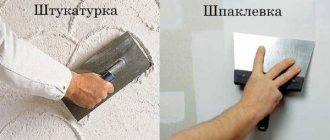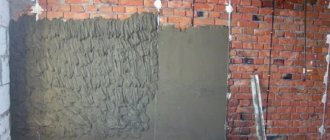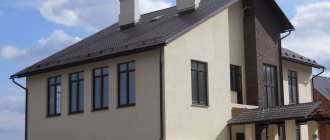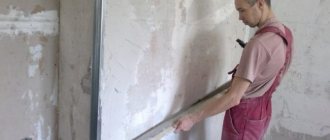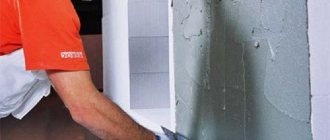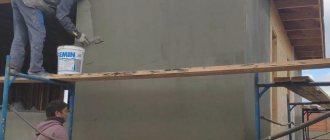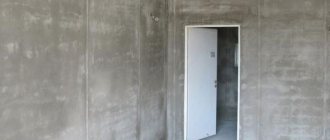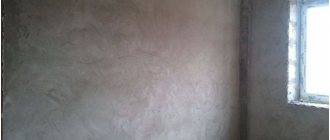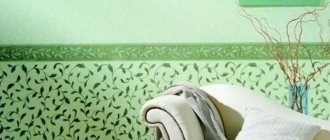- Plaster
- How to correctly calculate plaster consumption
- KNAUF ROTBAND
The finishing coating applied to cellular concrete masonry, in addition to providing an aesthetic appearance, also has protective functions. It insulates the masonry surface from mechanical damage and waterlogging, and reduces the likelihood of blowing through the walls to zero. The standard for finishing aerated concrete walls imposes certain requirements on vapor permeability, frost resistance, water absorption and adhesion. According to the unanimous opinion of experts, aerated concrete plaster is considered the best material that meets all these requirements at once. Why? You will learn about this by reading the material presented here.
Features of aerated concrete
This building material has a cellular structure, which gives it special properties:
- good thermal insulation - the characteristics of aerated concrete are comparable to wood;
- low mechanical stability, which leads to the appearance of cracks and chips over time;
- the porous material is blown by air currents, which is why houses made from it without finishing are considered quite cold;
- unaesthetic appearance;
- high absorbency leads to corrosion of the material in winter, during frosts.
The special structure of aerated concrete blocks requires careful processing with finishing materials to improve its quality characteristics. External plastering is carried out using special solutions that are selected for certain environmental conditions. Proper plastering of aerated concrete walls ensures reliable protection of the base and its durability, and also allows you to give a more aesthetic appearance to the room.
How and with what to plaster aerated concrete indoors?
Plastering aerated concrete walls with your own hands
Regardless of the type of plaster you choose, you need to start finishing work inside the room. Changing the order and plastering the facade of the building will lead to excess humidity in the room. The fact is that when steam leaves the room, especially in winter, condensation accumulates between the blocks and finishing, creating places with excess moisture. This is the main cause of cracks on the surface and crumbling of the plaster. To avoid such troubles, you should first start plastering the walls made of aerated blocks indoors. Experienced craftsmen distinguish two types of technology for plastering aerated concrete walls in a house:
- ensuring complete vapor barrier;
- maintaining and increasing the vapor permeability of the material.
The main element of plastering aerated concrete using the first technology is polyethylene film. It is fixed between layers of mortar, and the vapor permeability of the walls is reduced several times. Also for vapor barrier, oil paints are used, which are applied as a finishing touch, and priming the base with special compounds.
General information about cellular concrete
In addition to the standard ingredients for concrete mixtures in the form of cement and mineral components, cellular concrete is characterized by the presence of foaming additives. Under certain conditions, these additives contribute to the formation of voids inside the block. We have described the most popular scheme for the production of such materials, but lightweight concrete is not limited to it alone. In total, these products are divided into two types:
- Autoclaved. Hardening of these concretes occurs when exposed to steam under high pressure. Such conditions are achieved in special ovens - autoclaves. Examples of such concrete include aerated concrete and foam concrete;
- Non-autoclave. These concretes are hardened in special chambers or using electrical heating. At the same time, the hardening temperature is two times lower than in autoclaves. Expanded clay, algoporite, blast furnace slag and other materials similar in their technical parameters are used as fillers in such concrete.
The advantages of such blocks include their low mass, which allows the construction of lightweight but relatively durable structures. However, they still cannot be compared with ordinary concrete in terms of strength, which is why such materials are not used in multi-story construction. The disadvantage is that the blocks are very sensitive to moisture. Especially if they have open pores into which water seeps in very well.
Dependence of internal plastering technology on external finishing
To accurately determine the approach to interior work, you need to decide on exterior plastering. Plastering aerated concrete walls outside the room affects the method and sequence of actions for finishing the room:
- When the external wall already has some kind of coating or is insulated with dense and vapor-proof materials, moisture will accumulate in the walls. In this situation, interior finishing is carried out using materials with low vapor permeability. You also need to take care of a reliable ventilation system so that moisture does not accumulate in the corners of the room and on the windows.
- When a facade made of aerated concrete is not covered with anything, or is treated with porous insulation, such as mineral wool, then its vapor permeability is not impaired. In this case, it is necessary to first carry out work on the interior decoration of the room, and then move on to the exterior.
When can plastering begin after masonry?
You should not start covering the building with plaster immediately after its construction is completed. Blocks tend to shrink, no matter whether glue or another mortar was used during construction. Naturally, when the house begins to shrink, the plaster will lose its appearance and will simply be full of cracks, which will require re-coating the walls.
Plastering work is possible seven months after the completion of roof construction. Important! This period is counted precisely after the roof of the building is closed; it cannot be counted immediately after the completion of construction of only the walls of the building. The real pressure begins only with the presence of a roof.
Plastering work is possible seven months after the completion of roof construction.
Preparing the base
Plastering aerated concrete walls yourself
The technology for plastering aerated concrete walls is practically no different from working with any other surface. First of all, you need to make sure that the walls are smooth, and if they are not, sand them with a plane or aerated concrete float. Many craftsmen skip this stage, but as a result, the costs of plaster, which is also used to smooth out defects, increase. Before applying the primer, aerated concrete walls are wetted with water. For drier rooms, it is recommended to choose a universal composition, and for the kitchen and bathroom - a deep penetration primer. \
Construction beacons are mounted on the dried surface, which will serve as a guide for successful plastering of the room. After installing the beacons, the internal plaster of the aerated concrete walls will lie smoothly, and the work will progress faster.
The technology for finishing the façade of a building differs slightly from standards. First, the walls are cleaned of dust and leveled. Gaps and cracks are filled with special aerated concrete adhesive. After drying, it is necessary to apply a layer of primer for cellular materials. An important stage in the preparatory work for plastering the facades of aerated concrete buildings is reinforcing the surface with a mesh. When choosing the type of reinforcing mesh, you must pay attention to the fact that under the influence of an alkaline environment, the material from which it is made can dissolve. Experts recommend choosing fiberglass types.
What tools will you need for the job?
Plastering on gas silicate blocks is carried out using the following set of tools and devices:
- The rule is an indispensable device for pulling mortar along beacons, capable of ensuring ideal surface leveling. Beginners are recommended to choose a not very wide version of the device, 2 meters long;
- plastic container for preparing a working solution of the required volume. You can use a bucket, improvised containers in the form of containers or tanks in which it is convenient to dilute the required amount of plaster composition;
- electric drill with mixer. Since the volume of work ahead is quite large, it is worth using a special power tool to mix the solution. This allows you to significantly reduce time costs, optimize the speed of work and process efficiency;
- a special ladle for throwing the working mixture or a plasterer’s trowel. Depending on your preferences, you can choose a convenient version of this construction tool, which is presented in a wide variety of models;
- grater. Used to level the surface of the plaster layer;
- poluter. The tool is necessary to remove excess working mixture from the surface.
The rule is an indispensable device for pulling mortar along beacons.
The last two devices differ only in size.
How to plaster aerated concrete surfaces
In order for the repair of an aerated concrete house to last for many years, it is necessary to competently approach the choice of material for finishing the walls inside and outside. Masters distinguish four options for processing walls made of cellular material:
- Gypsum plaster.
- Cement-sand mortar.
- Facade mixtures.
- Drywall.
The last option is the so-called dry plaster. What is better than plasterboard or plaster on aerated concrete walls is a controversial issue. Plastering a surface is a costly and labor-intensive process. Working with gypsum plasterboard takes less time and, as a result, smooth walls are obtained. Procedure:
- vapor barrier of surfaces using polyethylene film, membrane or glassine;
- installation of lathing for fastening gypsum boards;
- fastening drywall to the frame;
- filling joints between sheets using serpyanka tape.
Any type of decorative finish can be applied to an aerated concrete wall leveled in this way. What plaster is best for plastering aerated concrete walls? To answer this question, it is necessary to know the specifics of solutions and their interaction with the base material.
Do-it-yourself exterior decoration
The plaster mixture according to SNiP is applied in three layers:
- spray (starting) - plaster thickness from 3 to 9 mm;
- ground (leveling) - from 7 to 9 mm (if the composition contains gypsum, then up to 12 mm);
- covering (finishing) - thin-layer plaster from 2 to 4 mm.
Tools for work
- beacon plaster profiles (guides);
- bubble level;
- container for preparing the solution;
- putty knife;
- plaster ladle or falcon;
- Master OK;
- rule (instead, you can make a template with your own hands);
- trowel;
- grout grater.
Plastering technology
- Attach the plaster mesh to the wall surface with self-tapping screws, which is needed to reinforce the starting layer.
- Glue the outer beacons (guides made of metal profile) in small portions of the solution.
- Check with a level that their position is correct.
- Pull two or three threads between the initial beacons.
- Install the remaining guides along the threads in increments slightly smaller than the width of the rule (about 1 m).
- Apply the prepared plaster mixture onto the surface with a trowel. Level it with a rule, moving it in a zigzag along the beacons.
- After the solution has dried, the verticality of the walls is checked using the rule. If necessary, another leveling layer is applied. The previous layer must be dry (usually this takes 1-2 days).
- After the finishing layer has completely dried, the plaster is rubbed with a special trowel, pressing it tightly to the surface. The walls are treated twice - in a circular motion clockwise, then in a straight line. To achieve a perfectly smooth finish, you can wrap the grater in felt or felt and once again treat the dried plaster with it.
If the walls of the house are insulated from the outside with mineral wool, then they can be plastered in the same way. The mesh is attached to the insulation layer with an adhesive solution. Then proceed in the same way as with conventional plastering.
Disadvantages of different types of plasters
| Name | Flaws |
| Cement | Low level of adhesion in relation to aerated block |
| High moisture content | |
| The vapor permeability rate is lower than that of a gas block, so cement mortar can only be used when using vapor-proof materials (polyethylene film, etc.) for interior finishing. | |
| Plaster | Collects moisture during snow and rain |
| The appearance of stains on the plaster | |
| Low vapor permeability | |
| Facade | The only drawback of this type of plasters is their high cost. |
Gypsum plaster
The main advantages of gypsum mortar for treating aerated concrete walls include:
- quick drying;
- high level of adhesion;
- there is no need to apply an additional smooth layer;
- Possibility of leveling the plaster for finishing.
Knauf Rotband, Bonolit and Pobedit Velvet are popular among craftsmen.
Cement-sand plaster
Plastering walls made of aerated concrete
If this option was nevertheless chosen for finishing aerated concrete walls, then there are several ways to improve the composition for better interaction with the base. You can increase adhesion by adding more cement mortar to the standard mixture recipe (for 100 kg of concrete you will need 8-10 kg of lime). The second option, which is acceptable, but still not recommended by craftsmen, is to add a mixture for processing aerated concrete (1:1 proportion) to the cement-sand plaster. Among the leaders in sales of mixtures of this type are solutions of the Baumit brand and domestic Craps Extra-light.
Facade solutions
This type of mixture, in the case of aerated concrete, is suitable for both interior and exterior use. The main positive aspects of working with special plasters for aerated concrete:
- high adhesion rate;
- resistance to deformation and cracking;
- vapor permeability is equal to that of aerated concrete;
- nice view;
- does not require additional finishing work.
Do-it-yourself plastering of walls on aerated concrete is demonstrated in the video below. With a competent approach to work and studying materials, even a novice master can cope with plastering a house made of aerated concrete blocks.
Review of brands of plaster mixtures
Today there is a considerable amount of plaster on the market, but the following are best suited for work on cellular concrete:
- Atlas KB-Tynk. This plaster is suitable for all types of cellular concrete, and is distinguished by its lightness;
- Ceresit ST 24. It is characterized by high adhesion to cellular concrete, as well as resistance to external influences and environmental safety;
- Mix mask. The composition of this finishing material contains quartzite and polymer modifiers. , states that its products perform particularly well in the Siberian climate;
- PROFIT CONTACT MN. A mixture of cement and sand is highly durable and able to withstand high levels of humidity. Can be used both for outdoor work and for finishing damp and unheated rooms. Applied by machine.
https://www.youtube.com/watch?v=-BPsuXsZ6d4
